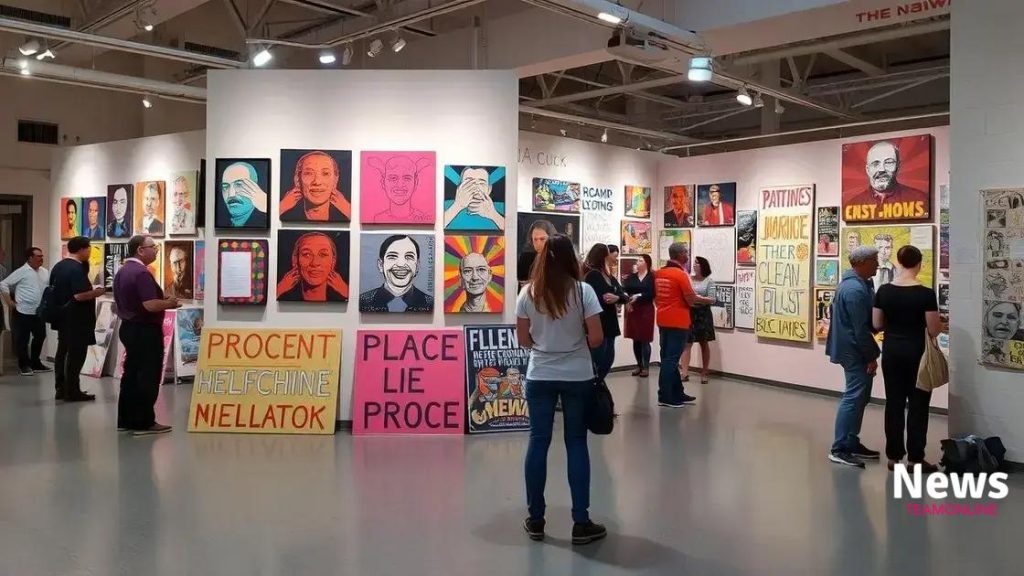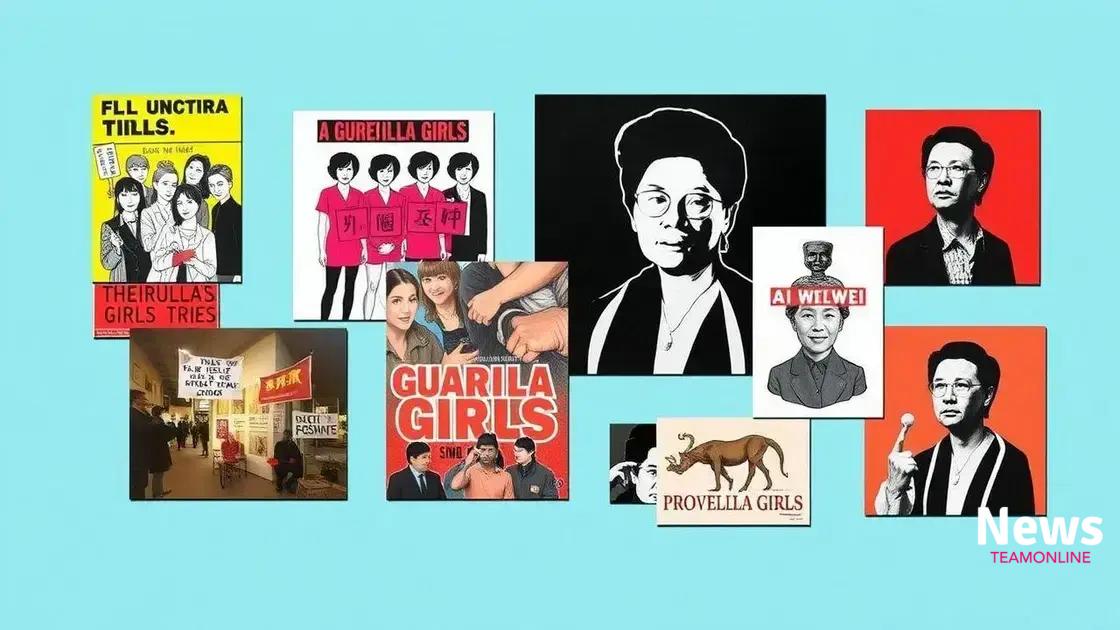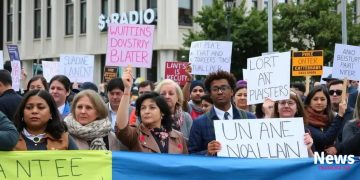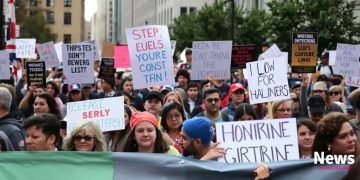Protest art exhibition legislation: what you need to know

Protest art exhibition legislation plays a vital role in protecting artists’ rights and shaping public discourse, as it evolves alongside societal movements and public opinion.
Protest art exhibition legislation plays a crucial role in shaping how artists express dissent and influence change. Have you ever wondered how laws impact these powerful displays of creativity? Let’s dive into this compelling issue.
Understanding protest art and its significance
Understanding protest art is essential to grasp its significance in society. This form of expression arises when artists convey messages against social injustices, political oppression, and human rights violations. Through various mediums, from paintings to installations, protest art brings awareness and inspires change.
The Impact of Protest Art
Protest art serves multiple purposes. It not only communicates dissent but also unites communities. Artists use their work to spark conversations and encourage activism.
Key Functions of Protest Art
- Raises awareness of societal issues.
- Encourages public engagement and dialogue.
- Provides a platform for marginalized voices.
- Transforms public space into a venue for discussion.
In many instances, protest art has a profound impact on societies. For example, murals and street performances can distill complex emotions into visual statements. These artworks often resonate deeply with the public, leading to greater understanding and action.
From historical events to contemporary issues, protest art reflects the zeitgeist. It captures the spirit of movements, such as those advocating for racial equality or environmental action. By portraying struggles and victories, artists immortalize the fight for justice.
Additionally, protest art often becomes a part of cultural heritage. It influences future generations and inspires ongoing movements. When people encounter powerful artworks in public spaces, they are compelled to reflect and react.
Ultimately, the significance of protest art lies in its ability to connect individuals with shared experiences. It fosters empathy and encourages people to stand together against oppression.
Key legislation affecting protest art exhibitions
Key legislation affecting protest art exhibitions plays a crucial role in the freedom of expression for artists. Laws can either support or restrict the creation and display of protest art, thus shaping public discourse.
Types of Legislation
Different types of laws influence protest art. These include copyright laws, public assembly regulations, and anti-vandalism laws. Understanding these laws helps artists navigate their creative expressions.
- Copyright laws protect artists’ original works.
- Public assembly laws can either allow or limit gatherings for protests.
- Anti-vandalism laws penalize unauthorized installations.
When artists create works that challenge the status quo, they often do so with the risk of legal repercussions. For example, several pieces have faced removal or destruction due to local ordinances. This has led to debates about the balance between artistic expression and community standards.
Recent Legal Developments
Recent legal changes have significantly influenced protest art. Some regions have enacted laws that protect public art, while others have tightened restrictions. These developments highlight the tension between government regulation and creative freedom.
Moreover, activists and organizations are working tirelessly to advocate for better legal protections. They aim to ensure that protest art maintains its place as a vital component of democratic expression.
The role of the judiciary is also important in shaping how laws are applied to protest art. Courts often interpret laws that impact exhibitions, which can lead to wider implications for artists nationwide.
As society evolves, so do the challenges faced by protest artists. Staying informed about key legislation is essential for creatives who wish to engage in socially relevant discussions.
Case studies of notable protest art exhibitions

Case studies of notable protest art exhibitions illustrate the power of art in addressing social issues. These exhibitions often gather attention and provoke discussions about critical matters affecting society.
1. The Guerrilla Girls
A famous group of feminist artists, the Guerrilla Girls expose gender and racial inequality in the art world. Their exhibitions feature provocative posters and installations that challenge the status quo, making them a significant reference in protest art. Their work inspires the audience to reflect on the representation of women and people of color in art.
2. “The Wall” by Ai Weiwei
Ai Weiwei’s installation, “The Wall,” addresses the global refugee crisis. This powerful exhibition uses thousands of life jackets to symbolize the lives displaced by conflict and persecution. Visitors are moved by the stark visual representation of human suffering, pushing them to consider the larger global implications.
3. “Clothing the World” by the Fashion Activism Collective
This exhibition showcases garments made by survivors of domestic violence. Each piece tells a story, emphasizing the intersection of fashion and activism. The exhibition raises awareness about women’s rights and provides a platform for survivors to express their experiences through art.
4. “A Beautiful Death” by Francesca Gabbiani
This installation challenges the norms of beauty in our society. By using artistic representations of dying flowers, Gabbiani sparks conversations about the fragile nature of life. The exhibition encourages attendees to reconsider their perceptions of beauty and mortality, deepening the discourse surrounding these themes.
Through these case studies, it’s evident that protest art exhibitions serve more than just aesthetic purposes. They spark critical conversations, inspire activism, and lead to societal change. By showcasing powerful narratives and visuals, these exhibitions create connections between artists and their audiences.
The role of public opinion in exhibition policies
The role of public opinion in exhibition policies is significant in shaping how protest art is displayed and received. Artists often rely on the sentiments of the community and the public to gauge the impact of their work. Understanding what people think can influence which exhibitions are funded and promoted.
Influencing Factors
Public opinion can be swayed by various factors, including media coverage, social media trends, and community values. When a piece of art resonates with the public, it can lead to increased visibility and support.
- Media coverage amplifies the reach of protest art.
- Social media enables artists and advocates to connect directly with audiences.
- Community values can encourage or discourage certain forms of expression.
Moreover, when exhibitions attract significant public interest, they often see greater attendance. For instance, public protests or social movements can prompt galleries to host related exhibitions, demonstrating how public sentiment can drive artistic showcases.
Shaping Exhibition Policies
Exhibition policies can change in response to public feedback. If community members express concerns about specific artworks, institutions may reconsider where and how art is displayed. This can lead to important discussions about censorship and artistic freedom.
Additionally, public opinion can lead to the creation of policies that better support protest art. For example, there have been instances where community outcry has resulted in the preservation of vital protest artworks, enhancing public engagement in local arts.
Ultimately, artists and curators must navigate the complexities of public opinion. By understanding audience reactions, they can create more impactful exhibitions that resonate deeply with the community.
Future trends in protest art legislation
Future trends in protest art legislation are shaping the landscape of expression in significant ways. As society becomes more engaged in various social movements, laws surrounding protest art are expected to evolve to either protect or regulate artistic expression.
Emerging Legal Protections
There is a growing awareness of the importance of safeguarding artists’ rights. New legislation may emerge to provide better protections for protest artists, ensuring they can express dissent without fear of repercussions. This trend encourages more artists to engage in socially relevant topics.
Increased Advocacy and Activism
Activism is likely to drive changes in protest art legislation. As communities rally around causes, there will be demands for reforms that enhance artistic freedoms. Grassroots movements are pushing for laws that not only defend protest art but also promote it as a valuable form of expression.
- Grassroots organizations advocating for artists’ rights.
- Increased funding for public art projects related to social justice.
- Legal frameworks addressing censorship in the art world.
Social media also plays a crucial role in shaping these trends. Discussions and campaigns on platforms can attract public attention, forcing policymakers to consider the impact of legislation on art and expression. This ongoing dialogue helps inform and mold future laws.
Global Perspectives
Internationally, different countries are responding to protest art in varied ways. Some are adopting more progressive laws that encourage free expression, while others clamped down on dissenting voices. The worldwide nature of art activism fosters a rich exchange of ideas and strategies for securing artistic freedom.
The discourse around protest art legislation continues to expand as cultural movements gain momentum. Artists, activists, and communities are working together to advocate for changes that ensure their voices remain heard. The future holds exciting possibilities for how legislation may evolve to better support the vital role of protest art.
FAQ – Frequently Asked Questions about Protest Art Legislation
How does public opinion influence protest art exhibitions?
Public opinion can determine which protest art is showcased, influencing funding and support for exhibitions.
What are some examples of notable protest art exhibitions?
Examples include the work of the Guerrilla Girls and Ai Weiwei’s installations, both addressing social justice issues.
What legal protections exist for protest artists?
Legal protections vary by region, but there is a growing movement advocating for laws that safeguard artists’ rights.
How can activists support protest art legislation?
Activists can engage in grassroots movements, raise awareness, and advocate for reforms that promote artistic freedom and expression.





